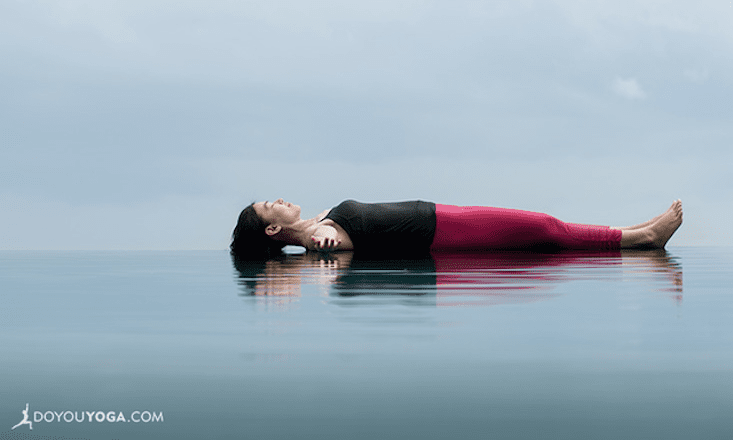Yoga Nidra is a practice that can take you to the next level; a relaxed body, fluid mind, and supercharged intuition.
Yoga Nidra, translated as yogic sleep, is a five-stage process that begins with a body scan to engage one’s physicality. It incorporates meditation on the breath, the balancing of emotional states, visualization, and self-healing. Setting a positive intention is another important step (which is called a sankalpa) and this gives the participant a specific purpose to the session.
The Depths and Benefits of Yoga Nidra
During Yoga Nidra, we let our awareness wander through the whole body. While doing so, we move through different stages of consciousness just as in sleep: We shift between the waking state, dream state, and finally to deep, dreamless sleep.
It creates deep relaxation for health, mental peace, and higher awareness. Swami Rama has been quoted to say that Yoga Nidra is a practice of self mastery of the autonomic nervous system. The technique is practical and easily accessible.
Relaxation exercises and pratyahara are used to prepare the mind and body for Yoga Nidra by balancing the right and left hemispheres of the brain and stimulating the subtle energies of our vital force, the prana.
It’s said that 45 minutes of Yoga Nidra is as restorative as 3 hours of sleep. What does this mean? By receiving the proper rest, we enhance functioning of the immune and metabolic systems. In turn, this improves our overall physical health and leads to higher energy as well as fewer colds and infections of all types. Rest also improves mental health, eliminating brain fog, insomnia, anxiety attacks, PTSD, and depression.
Yoga Nidra Breakdown: The Main Stages for All Levels
Preliminary Relaxation Technique
We engage in simple breathing exercises to release tension and trigger the nervous system to induce a state of parasympathetic activation.
Creating a Sankalpa (Intention or Resolve)
This intention is something we wish to manifest in any area of our life or a quality we wish to cultivate and/or embody. For example, someone might want to manifest fearlessness, courage, inner peace, or fulfillment.
Stage 1: Rotation of Awareness Through the Body
The primary objective in this stage is to isolate the mind. The mind is focused, alert, and separated from external stimuli. We separate from the body, from the senses, and from their need for attention.
So we create pratyahara (sense withdrawal) and command control over the sensory mechanisms of the physical body, specifically through exercises which deal with the mapping of the brain. Pratyahara opens the gate to the contents of the subconscious and unconscious levels of mind.
The science behind this stage is simply to make use of the principle of homunculus, or the walking sensation through the cerebral cortex. The mapped stimulation through the brain relaxes the motor and sensory regions, thereby relaxing the body and the mind.
“A cortical homunculus is a pictorial representation of the anatomical divisions of the primary motor cortex and the primary somatosensory cortex, i.e., the portion of the human brain directly responsible for the movement and exchange of sensory and motor information of the body. It is a visual representation of the concept of ‘the body within the brain’ — that one’s hand or face exists as much as a series of nerve structures or a “neuron concept” as it does in a physical form.”
Image Credit and Text Source: Boundless. “Mapping Primary Somatosensory Area.” Boundless Anatomy and Physiology. Boundless, 14 Nov. 2014; https://www.boundless.com/
Stage 2: Awareness of Prana
The objective here is not only to enhance our ability to be aware and connected to our emotional responses, but also to work with the subtle body. We want to become mindful of the realms that lie beyond body and experience the pranic tide of breath without judgement. Through breathing techniques, we continue withdrawal from the external body and continue momentum of the inward journey.
Stage 3: Awareness of Feeling and Emotion
Our aim at this stage is to use the interaction of polarized emotional experience through a type of word association. We want to dissolve our attachment to emotional and conditional programming that lies hidden from conscious awareness in the subconscious mind.
“With detachment and without fear we observe the polarizations then seek an equilibrium to their experience to culminate indifference. Experiencing both waves of a feeling or emotion can have significant impact on releasing stored effect of past experience. We simply invite without added distortion what ever may arise remaining fixed on observing the intensity, and flavour of each experience and even where in the body it’s centred.”- Everett Newell
Stage 4: Visualization
At this stage, we access and work with contents of the unconscious mind and samskaras which are our mental and emotional patterns, individual impressions, ideas, or actions. Together, our samskaras make up our programming.
Here, guidance through a series of archetypal images or a guided visualization in form of a vivid journey will evoke responses in our relaxed mind. We cleanse and heal the mine field of deep-rooted conditioning.
The Final Step
We revisit our intention (sankalpa) and plant it into the field of the unconscious mind. We then return awareness back to the body.
Yoga Nidra takes us through a magical process of releasing the physical body, quieting the brain waves, tapping into our emotional body, and gaining a higher intellect. Even a beginner can enter profoundly deep states of consciousness just the same as any experienced meditator.
It’s time. Take your practice to the next level.
Did you know?
When you commit to building heathy sleep habits, you take the first step to become your healthiest self – one full night of good sleep at a time. Check out our Complete Guide to Sleep Disorders – a resource to help you get your quality sleep back. Learn more about sleep disorders, their causes, symptoms and how to overcome them.



